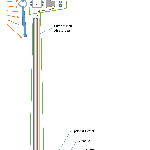 Tim Elder Jul 19, 2014 07:44 |
Thinking out loud:
There will be losses due to heat escape from the compressed air,but I know next to nothing about thermodynamics. Do you have any estimates on the efficiency versus other methods?
It is conceivable that the support shaft could be the pressure tank, thus eliminating the pipes, but I don't think the shaft walls would withstand the pressure required. Plus, unless highly insulated, there would be heat loss due to conduction thru the shaft walls.
Depending on how they are supported, the pipes could add to the stiffness of the shaft. But, knowing that diameter contributes a bunch to stiffness, means that the pipes won't really do much.
|
 Ben Kaippallil Jul 20, 2014 11:54 | Proposal contributor
Thanks for your comment timewelder.
Yes compression will result in higher temperatures.
It follows the ideal gas equation PV=nRT.
This heat could be removed with the help of intercoolers/heat exchangers. Following the latest adiabatic storage methods, this heat could be stored and recirculated to heat up the compressed air as it expands. In this way we would not need an external fuel source to provide the heat.
The heat generated could also be removed from the system to support a heating load in some urban areas.
Efficiencies-
Centrifugal compressors could have efficiencies as high as 92%. It depends on the deviation of operational conditions against design conditions.
Electrical generators have efficiencies in the range of 95-98% at design conditions.
This machine would make sense only for energy storage systems and hence the main problem that it hopes to tackle is the redundancy of first converting wind energy into electricity and then into compressed air for storage.
Well I could imagine storing compressed air in the tower itself, although, as you pointed out, the design and manufacturing of the tower would be quite complicated. I guess using standard pipes would be easier to install and maintain.
|
 Francois Allard Aug 6, 2014 10:50 |
Interesting idea.
I read somewhere that storage at the turbines would increase the number of turbines that can be served by a power distribution infrastructure (wires).
Storage ideas here:
http://spectrum.ieee.org/energywise/energy/renewables/an-energystoring-wind-turbine-would-provide-power-247
2 more ideas.
1) Directly generate a portion of the turbine energy in the nacelle and use this same generator (possibly in reverse) to generate power from the compressed air when the wind isn't blowing and energy is needed. The heat store can be closer to the nacelle with less piping and loses. It would require some sort of disconnect from the blades. It would reduce cost and increase efficiency.
2) Link a number of towers by air pipes and use a single larger expander/generator. Heat recovery might again be a single larger interconnected heat engine.
|
 Ben Kaippallil Aug 7, 2014 04:52 | Proposal contributor
Hi eph,
Thanks for your comment. I like you’re ideas as well. I guess the biggest engineering challenges would be in designing the interfaces between the elements, like the “disconnect” that you mentioned.
Hey I am up for collaborators… if you're interested :)
|
 Climate Colab Aug 13, 2014 04:21 |
The main drawback of wind turbines has been the intermittent nature of favorable wind. This can be somewhat offset by building a network of geographically dispersed wind farms. But even this does not eliminate the need for back up power.The proposal involves using the mechanical energy of the windmill's shaft to power an air compressor directly. This reservoir of compressed air can then be used to power a generator during periods in which the wind is not blowing. This approach should certainly be more efficient than siphoning off some of the electricity to power an electric compressor because it reduces losses associated with energy conversion. Of course, electric compressors are readily available and, since they are mass produced, are relatively inexpensive.In my mind, the question is whether the efficiency gains of this tailored device creates sufficient savings to offset the benefits of using a standard off the shelf product.I think some additional information would strengthen the proposal. For example:1. How many wind farms use electrical compressors to store energy? That is, what is the size of the current market?2. What are the energy losses associated with the use of the electrical compressors. That is, losses from converting the wind's mechanical energy to electricity and the losses of converting the electrical energy into mechanical energy for the compressor. These are all published numbers and they will set an upper limit on net potential efficiency gain.3. What is the cost of the electricity produced by the wind farm?4. What would be the maximum possible savings a wind farm could achieve by using directly connected mechanical instead of electrical compressors. In either scenario, some of the wind's energy is being siphoned out to power the compressor. Also, in either scenario the compressed air is being used as a vehicle to store the energy and potentially displace peak generation powered by fossil fuels. So the net saving associated with this proposal will come from the value of efficiency gains. Of course, a real device will not be able to realize 100% the maximum potential savings as calculated using this approach. However, it will provide an upper limit of the value of the concept, which may or may not support the development of a prototype.
|
 Mark Johnson Aug 14, 2014 09:04 |
Very interesting. This is similar to energy storage within BB guns (triggered air releases from pistol or rifle air cylinders). No disrespect, just a metaphor. Compressed air release must have similar wind turbine force, effect and mechanical advantage (i.e., similar to air passing over each wind turbine blade, resulting in the same or higher rotational speed). The discriminator seems to be the compressor's effective "drag" coefficient on the rotational velocity of the shaft on the turbine blades, thereby reducing KWh output (vs. higher Kwh production of the same wind turbine without an air compressor).
|
 Ben Kaippallil Aug 21, 2014 03:57 | Proposal contributor
Thanks for your input ecoelite! I do understand your concerns about the aerodynamic efficiency of the compressor. In my idea the compressor could be a positive displacement type compressor
(reciprocating, screw etc.) or a dynamic compressor (axial, centrifugal). A positive displacement compressor such as a resiprocating piston does not need to run at extremely high speeds as in the case of axial/centrifugal turbines.
For reciprocating compressors the output pressure is always constant, only the flow rate differs. As we are only concerned with storing the pressurized air I believe that the fluctuations in wind speed can be very well compensated by a multi-cylinder reciprocating compressor. Say for example very low wind speeds are incident on the turbine, in that case only one of the multiple pistons would compress air. As the wind speed increases more cylinders can be used until the maximum rated speed is reached. There are so many variable-load reciprocating compressors around the world that use similar concepts and they are all known to have very high efficiencies.
I would like to use this forum to add to my idea (I would have added it in the proposal itself, but there seems to have been a misunderstanding regarding the deadline, the official email states "21st August midnight")
The core of the idea is slightly more abstract-
I predict that by placing a compressor in the line of flow of the wind turbine we would be able to extract more energy in the form of compressed air as opposed to just rotary torque/ electrical energy.
My reasoning:
The Betz/Lancaster rule for wind turbines sets the maximum efficiency of a wind turbine at 59.3%. This makes complete sense if we consider a wind turbine focused on converting kinetic energy into a rotating moment. The rule makes the assumption that "wind" is incompressible.
I hypothesize that if the sole purpose of the machine was to produce compressed air and this air is extracted out of the wind itself, then the assumption that the flow is incompressible may not be true. The main reason why the Betz limit is 59.3% is because of the fact that normally the volume of the exiting column of air (downstream of the turbine) expands.This is because it would be impossible for an incompressible stream to "converge" if its velocity reduces. With a compressor placed axially in the flow of wind, as the air compresses, it "frees up room" for more air to follow. This is exactly what will cause the increase in efficiency of the turbine.
I think the idea could be best described a symbiotic relationship where the wind turbine drives the compressor and in turn the compressor increases the efficiency of the wind turbine.
But offcourse this is just an idea and it requires some scientific analysis.Or maybe I overlooked something very trivial. Either way I am hoping for some nice feed back.
|
 Mark Johnson Aug 21, 2014 08:10 |
Supra impressive narrative BGK. You have the requisite knowledge describing the interplay among physical forces, components and effects. Wow. Did you stay at a Holiday Inn Express? Have you seen those commercials?
|
 Climate Colab Sep 3, 2014 12:27 |
The contributor proposes using the mechanical energy of the windmill's shaft to power an air compressor directly to store energy to power a generator during periods in which the wind is not blowing. The main stakeholder that would be interested in exploring this project would be wind equipment manufacturers, that, if successful, would be able to develop more project, exploiting the energy storage capabilities. A more detailed theoretical analysis should be done in conjunction with the R&D department of a wind turbine manufacturer. They could also sponsor a Master Thesis on the subject if found reliable. If the technology is proven, they would be the most motivated and prepared first adopters for a quick introduction.
Proposal to develop a wind turbine that generates compressed air instead of electricity (thus allowing a constant output from a wind power generator). The efficiency and economics of the proposed device is not well supported in this proposal. I suspect the efficiency of compressed air generation will suffer substantially due to variability in wind resource availability (This is not considered in the current proposal). Nonetheless, this is worthy of initial high level conceptual calculations to see if it is feasible.
|
 Osero Shadrack Tengeya Sep 17, 2014 03:15 |
Hi BGK and your friends, consider voting for my proposal shown on this link.
https://www.climatecolab.org/web/guest/plans/-/plans/contestId/1300206/planId/1002
Thanks.
|
 Anne-marie Soulsby Sep 23, 2014 03:58 |
Hi BGK,
Please consider voting for my proposal, https://www.climatecolab.org/web/guest/plans/-/plans/contestId/1300801/planId/1309001
Good luck with your entry!
Asante/Thank-you
@conserveaction
|
 Ben Ramos Feb 1, 2016 07:33 | Savvy analysis ! For what it's worth , if someone is wanting a a form , my husband used a blank form here http://pdf.ac/436A3V. |
 Pauline Davidsoun Feb 1, 2016 07:03 | Creative blog post - I was fascinated by the details ! Does someone know where my company could get ahold of a fillable a form copy to complete ? |
